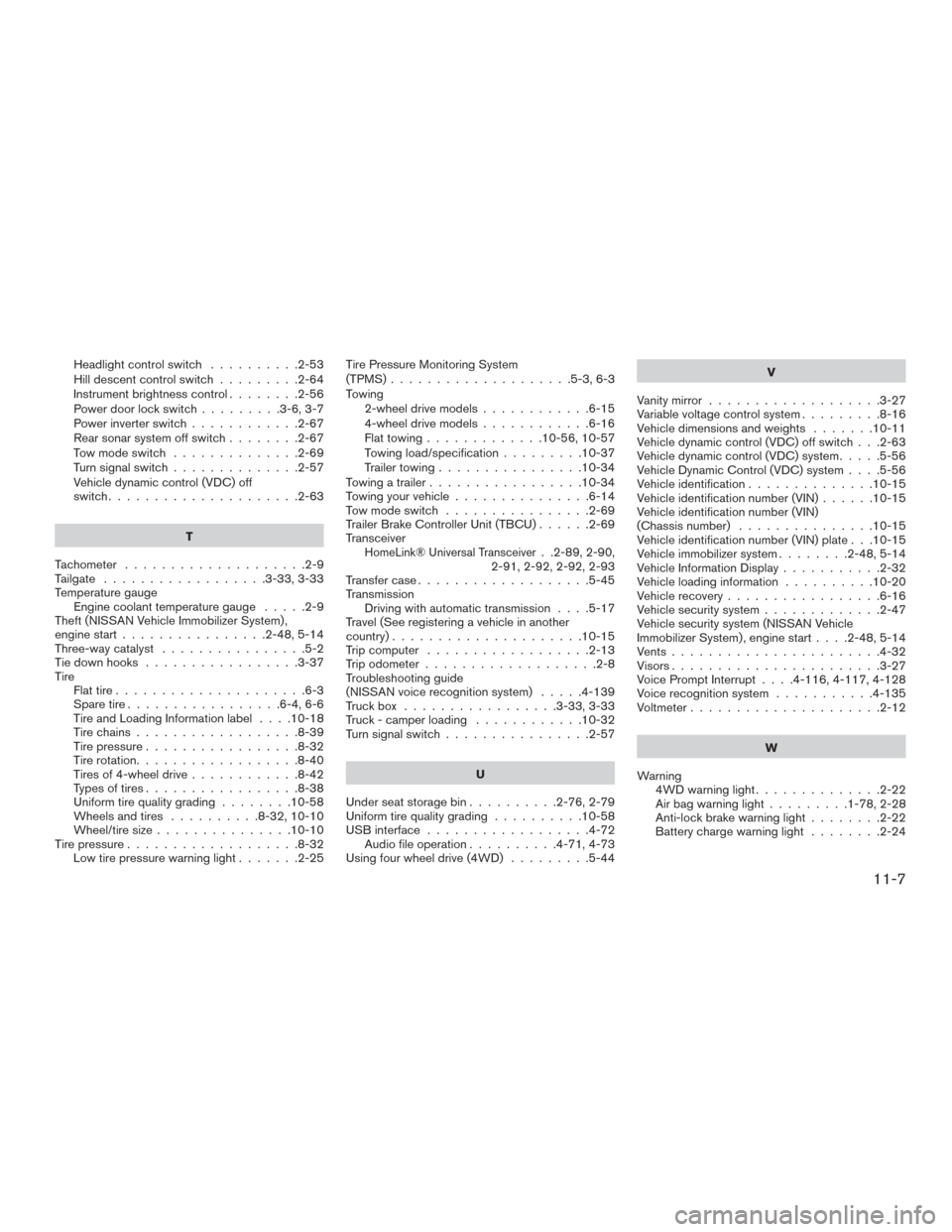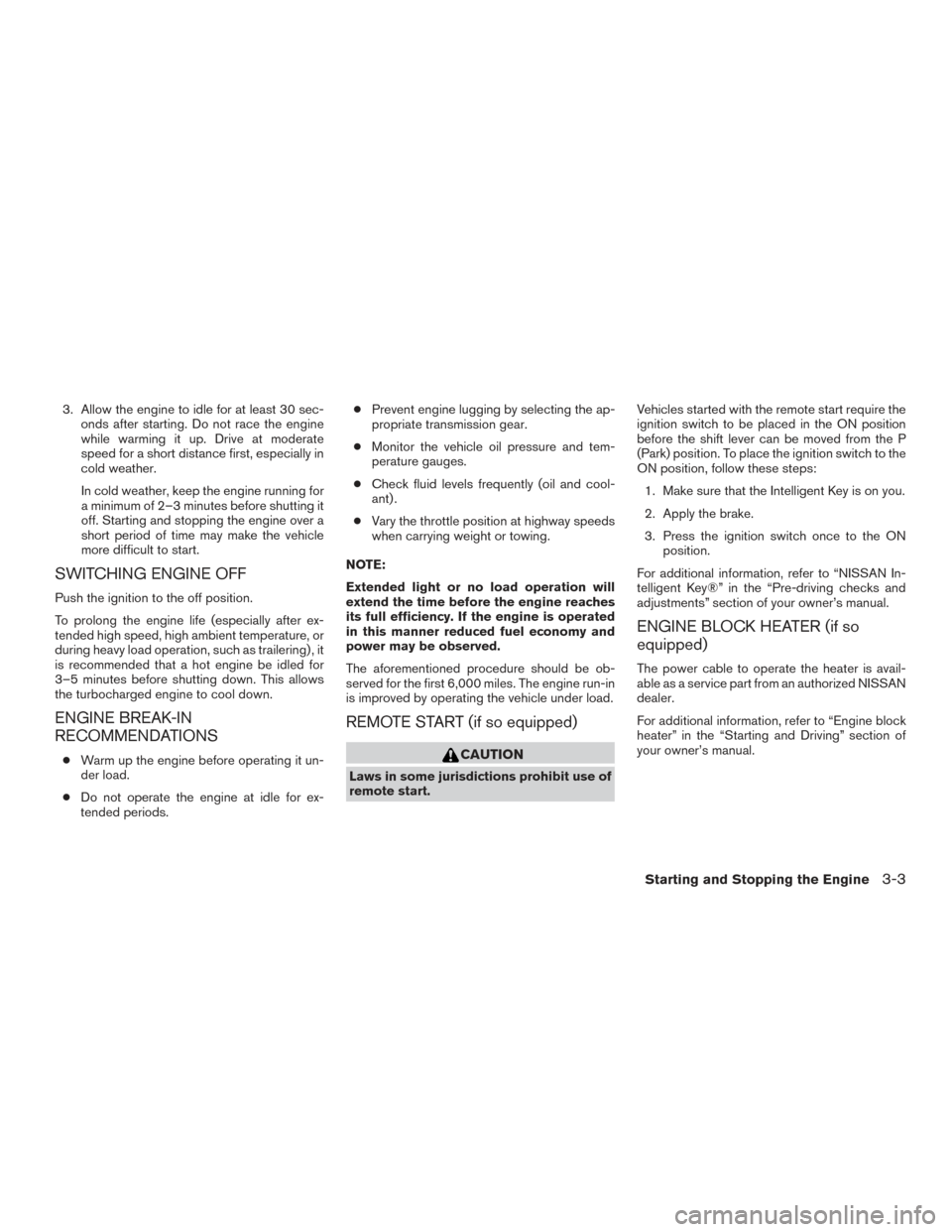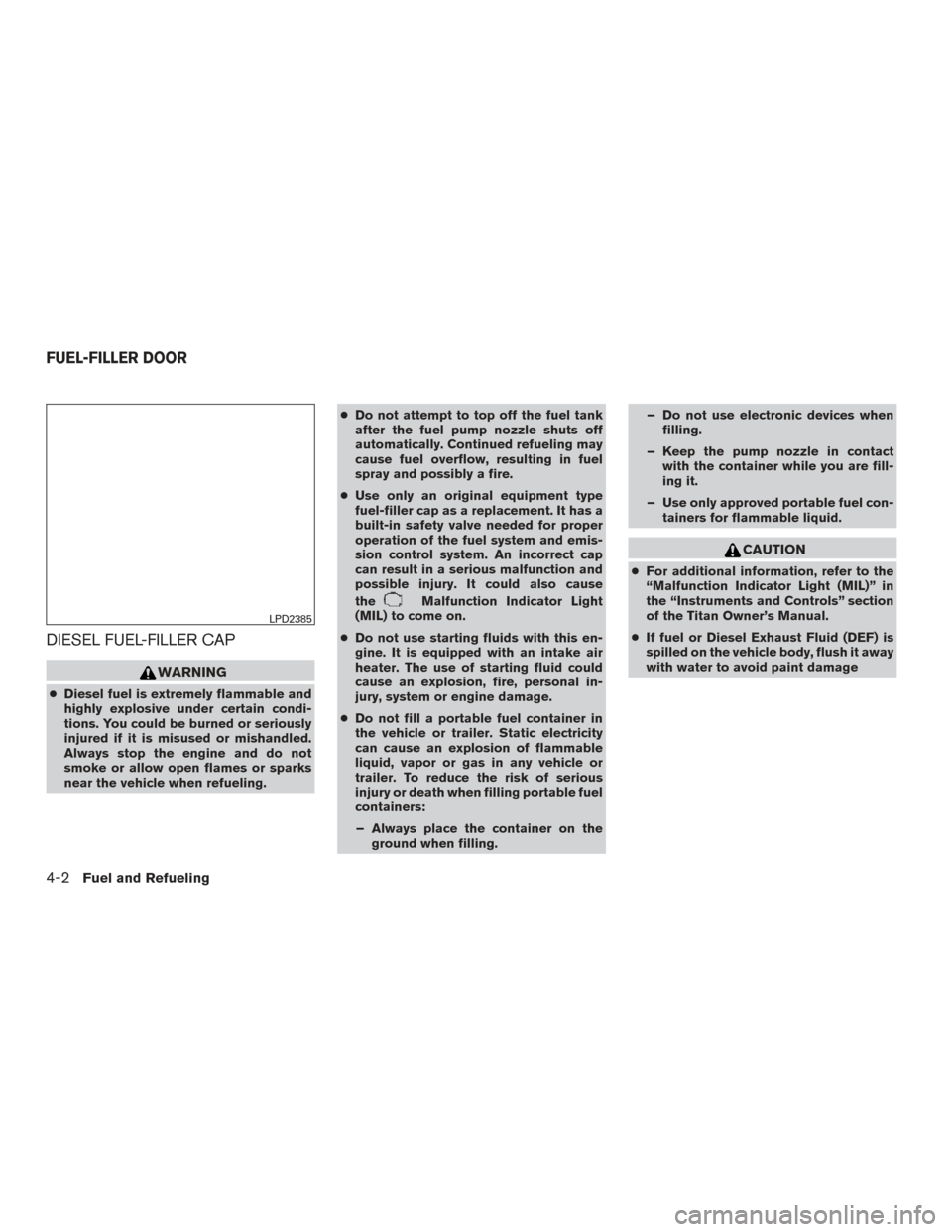Page 604 of 671

Headlight control switch..........2-53
Hill descent control switch .........2-64
Instrument brightness control ........2-56
Power door lock switch .........3-6,3-7
Power inverter switch ............2-67
Rear sonar system off switch ........2-67
Tow mode switch ..............2-69
Turnsignalswitch..............2-57
Vehicle dynamic control (VDC) off
switch.....................2-63
T
Tachometer ....................2-9
Tailgate ..................3-33,3-33
Temperature gauge Engine coolant temperature gauge .....2-9
Theft (NISSAN Vehicle Immobilizer System) ,
engine start ................2-48,5-14
Three-way catalyst ................5-2
Tie down hooks .................3-37
Tire Flat tire .....................6-3
Spare tire .................6-4,6-6
TireandLoadingInformationlabel ....10-18
Tire chains ..................8-39
Tirepressure.................8-32
Tire rotation..................8-40
Tires of 4-wheel drive ............8-42
Types of tires .................8-38
Uniform tire quality grading ........10-58
Wheels and tires ..........8-32,10-10
Wheel/tire size ...............10-10
Tirepressure...................8-32 Low tire pressure warning light .......2-25Tire Pressure Monitoring System
(TPMS)
....................5-3,6-3
Towing 2-wheel drive models ............6-15
4-wheel drive models ............6-16
Flattowing.............10-56,10-57
Towing load/specification .........10-37
Trailer towing ................10-34
Towing a trailer .................10-34
Towingyourvehicle...............6-14
Tow mode switch ................2-69
Trailer Brake Controller Unit (TBCU) ......2-69
Transceiver
HomeLink® Universal Transceiver. .2-89, 2-90,
2-91, 2-92, 2-92, 2-93
Transfer case ...................5-45
Transmission Driving with automatic transmission ....5-17
Travel (See registering a vehicle in another
country) .....................10-15
Trip computer ..................2-13
Trip odometer ...................2-8
Troubleshooting guide
(NISSAN voice recognition system) .....4-139
Truckbox .................3-33,3-33
Truck - camper loading ............10-32
Turn signal switch ................2-57
U
Under seat storage bin ..........2-76,2-79
Uniform tire quality grading ..........10-58
USB interface ..................4-72
Audio file operation ..........4-71,4-73
Using four wheel drive (4WD) .........5-44 V
Vanity mirror ...................3-27
Variable voltage control system .........8-16
Vehicle dimensions and weights .......10-11
Vehicle dynamic control (VDC) off switch . . .2-63
Vehicle dynamic control (VDC) system .....5-56
Vehicle Dynamic Control (VDC) system . . . .5-56
Vehicle identification ..............10-15
Vehicle identification number (VIN) ......10-15
Vehicle identification number (VIN)
(Chassis number) ...............10-15
Vehicle identification number (VIN) plate . . .10-15
Vehicle immobilizer system ........2-48,5-14
Vehicle Information Display ...........2-32
Vehicle loading information ..........10-20
Vehicle recovery .................6-16
Vehicle security system .............2-47
Vehicle security system (NISSAN Vehicle
Immobilizer System) , engine start ....2-48,5-14
Vents.......................4-32
Visors.......................3-27
Voice Prompt Interrupt ....4-116, 4-117, 4-128
Voice recognition system ...........4-135
Voltmeter.....................2-12
W
Warning 4WD warning light ..............2-22
Airbagwarninglight.........1-78,2-28
Anti-lock brake warning light ........2-22
Battery charge warning light ........2-24
11-7
Page 627 of 671

3. Allow the engine to idle for at least 30 sec-onds after starting. Do not race the engine
while warming it up. Drive at moderate
speed for a short distance first, especially in
cold weather.
In cold weather, keep the engine running for
a minimum of 2–3 minutes before shutting it
off. Starting and stopping the engine over a
short period of time may make the vehicle
more difficult to start.
SWITCHING ENGINE OFF
Push the ignition to the off position.
To prolong the engine life (especially after ex-
tended high speed, high ambient temperature, or
during heavy load operation, such as trailering) , it
is recommended that a hot engine be idled for
3–5 minutes before shutting down. This allows
the turbocharged engine to cool down.
ENGINE BREAK-IN
RECOMMENDATIONS
● Warm up the engine before operating it un-
der load.
● Do not operate the engine at idle for ex-
tended periods. ●
Prevent engine lugging by selecting the ap-
propriate transmission gear.
● Monitor the vehicle oil pressure and tem-
perature gauges.
● Check fluid levels frequently (oil and cool-
ant) .
● Vary the throttle position at highway speeds
when carrying weight or towing.
NOTE:
Extended light or no load operation will
extend the time before the engine reaches
its full efficiency. If the engine is operated
in this manner reduced fuel economy and
power may be observed.
The aforementioned procedure should be ob-
served for the first 6,000 miles. The engine run-in
is improved by operating the vehicle under load.
REMOTE START (if so equipped)
CAUTION
Laws in some jurisdictions prohibit use of
remote start. Vehicles started with the remote start require the
ignition switch to be placed in the ON position
before the shift lever can be moved from the P
(Park) position. To place the ignition switch to the
ON position, follow these steps:
1. Make sure that the Intelligent Key is on you.
2. Apply the brake.
3. Press the ignition switch once to the ON position.
For additional information, refer to “NISSAN In-
telligent Key®” in the “Pre-driving checks and
adjustments” section of your owner’s manual.
ENGINE BLOCK HEATER (if so
equipped)
The power cable to operate the heater is avail-
able as a service part from an authorized NISSAN
dealer.
For additional information, refer to “Engine block
heater” in the “Starting and Driving” section of
your owner’s manual.
Starting and Stopping the Engine3-3
Page 630 of 671

DIESEL FUEL-FILLER CAP
WARNING
●Diesel fuel is extremely flammable and
highly explosive under certain condi-
tions. You could be burned or seriously
injured if it is misused or mishandled.
Always stop the engine and do not
smoke or allow open flames or sparks
near the vehicle when refueling. ●
Do not attempt to top off the fuel tank
after the fuel pump nozzle shuts off
automatically. Continued refueling may
cause fuel overflow, resulting in fuel
spray and possibly a fire.
● Use only an original equipment type
fuel-filler cap as a replacement. It has a
built-in safety valve needed for proper
operation of the fuel system and emis-
sion control system. An incorrect cap
can result in a serious malfunction and
possible injury. It could also cause
the
Malfunction Indicator Light
(MIL) to come on.
● Do not use starting fluids with this en-
gine. It is equipped with an intake air
heater. The use of starting fluid could
cause an explosion, fire, personal in-
jury, system or engine damage.
● Do not fill a portable fuel container in
the vehicle or trailer. Static electricity
can cause an explosion of flammable
liquid, vapor or gas in any vehicle or
trailer. To reduce the risk of serious
injury or death when filling portable fuel
containers:
– Always place the container on the ground when filling. – Do not use electronic devices when
filling.
– Keep the pump nozzle in contact with the container while you are fill-
ing it.
– Use only approved portable fuel con- tainers for flammable liquid.
CAUTION
●For additional information, refer to the
“Malfunction Indicator Light (MIL)” in
the “Instruments and Controls” section
of the Titan Owner’s Manual.
● If fuel or Diesel Exhaust Fluid (DEF) is
spilled on the vehicle body, flush it away
with water to avoid paint damage
LPD2385
FUEL-FILLER DOOR
4-2Fuel and Refueling
Page 666 of 671
Operation under the following conditions may
require more frequent oil and filter changes:● repeated short distance driving at cold out-
side temperatures
● driving in dusty conditions
● extensive idling
● towing a trailer
● stop and go commuting
● you must also change your oil and filter when
the “Service Due Now” message is dis-
played.
For additional information, refer to the “Titan
Owners Manual”.
8-6Capacities and Specifications